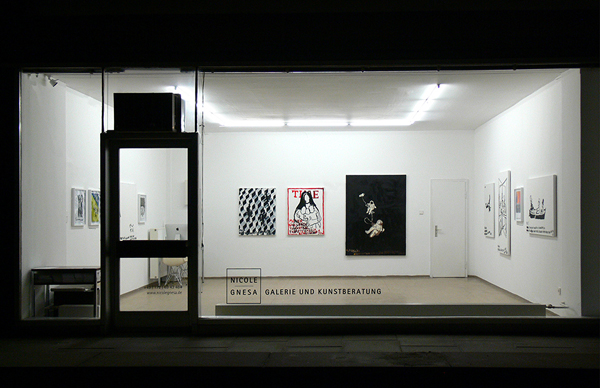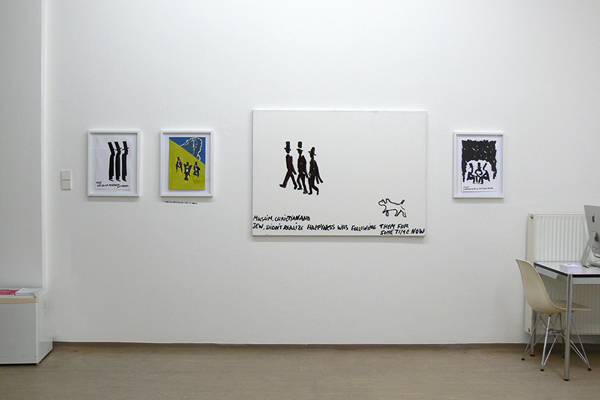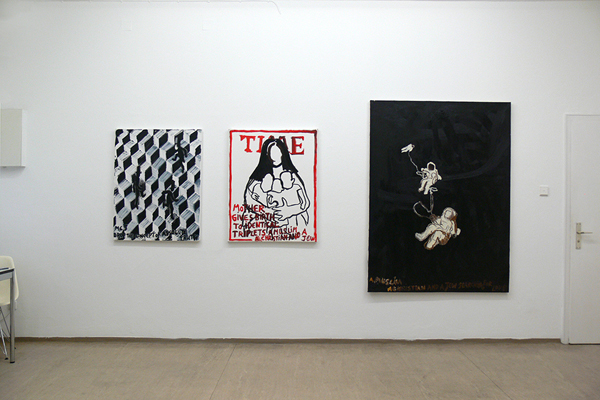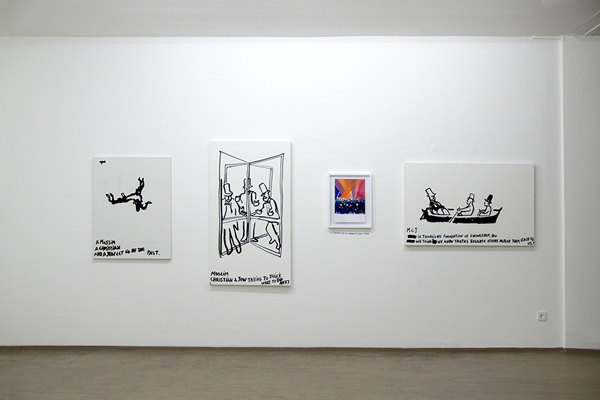 |
ARTISTS | EXHIBITIONS | NEWS | BOOKS | CONTACT | ||
|
Eran Shakine: A Muslim, a Christian, and a Jew Opening: November 9, 2023, 6-9 pm Exhibition: November 10, 2023 - January 14, 2024 Nicole Gnesa is very proud to present works from the series 'A Muslim, a Christian, and a Jew' by Eran Shakine (*1962 Tel Aviv) from November 9 to December 16, 2023. The Israeli artist Eran Shakine (*1962), himself the child of Holocaust survivors, persistently titles each one of his drawings with the same phrase, “a Muslim, a Christian, and a Jew,” almost as though he wanted to begin telling a joke. Eran Shakine represents the figures of the three world religions as “identical triplets,” letting them wander through his visual universe as indistinguishable personifications. The headline of a (fictional) drawn cover of the Times announces a “Mother gives birth to identical triplets: a Muslim, a Christian, and a Jew.” But only the artist’s title indicates that these are religious characters. The linguistic markers, not the figurative depiction, are what transmit the information of religious affiliation. In their indistinguishability the three figures appear abstract, not just in the sense that one can stand for the other, but also that separations between them are fundamentally erased. Later, the three gentlemen, usually in top hats and black suits, roam all over the world: wandering through the human cultures in this world or flying beyond the world’s boundaries into the hereafter. In his drawings Eran Shakine seems to explore God and the entire world. Eran Shakine’s oil stick paintings, which he now also realizes as cutouts and in colorful acrylic painting, are built up line for line as anti-caricatures: exaggeration or stereotype cliches are entirely absent as distinguishing characteristics among the three continually reiterated figures as representatives of the three world religions. Instead, his drawings fuse the distanced atmosphere of the characters from Samuel Beckett’s Waiting for Godot2 with the easy recognizability of the stenciled graffiti of street art drawings by Banksy and the delight in the burlesque graphic play of comic book illustrations. However, one also detects the Enlightenment seriousness of the famous ring parable from Gotthold Ephraim Lessing’s drama of ideas Nathan the Wise.3 Eran Shakine seems to present us with Lessings’s ring parable in drawing after drawing, of how questionable —in the most literal sense—the claim of an ideological preeminence by any of the three monotheistic religions is and how necessary the defense of a fundamental notion of tolerance is. In his unending play with visual references—that also extends to art history—as well as in his visual allusions and contentual ambiguities, Eran Shakine ironically sets an undrawn question mark after everything—including after God. Moments of comicality emerge from the constant repetition in the drawings, which one can perhaps best approach through the French philosopher Henri Bergson and his reflections on laughter. Bergson analyzed laughter as the greatest differentia specifica of humans, of what makes us human.4 He shows that laughter always presupposes a human society: “the comic does not exist outside the pale of what is strictly human.”5 Consequently, the absence of laughter can be diagnosed as the loss of the formation of community. It was the seventeenth-century French philosopher Blaise Pascal—as Bergson reminds us—who pondered over the following riddle: “‘Two faces that are alike, although neither of them excites laughter by itself, make us laugh when together, on account of their likeness.’ It might just as well be said: ‘The gestures of a public speaker, no one of which is laughable by itself, excite laughter by their repetition.’ The truth is that a really living life should never repeat itself. Wherever there is repetition or complete similarity, we always suspect some mechanism at work behind the living. […] This deflection of life towards the mechanical is here the real cause of laughter.”6 Bergson, moreover, cleverly argues for the combination of laughter and aesthetics: “Laughter, then, does not belong to the province of aesthetics alone, since unconsciously […] it pursues a utilitarian aim of general improvement. And yet there is something aesthetic about it, since the comic comes into being just when society and the individual, freed from the worry of self-preservation, begin to regard themselves as works of art.”7 In this, Bergson is serious about laughter: “In a word, if a circle be drawn round those actions and dispositions—implied in individual or social life—to which their natural consequences bring their own penalties, there remains outside this sphere of emotion and struggle—and within a neutral zone in which man simply exposes himself to man’s curiosity—a certain rigidity of body, mind and character that society would still like to get rid of in order to obtain from its members the greatest possible degree of elasticity and sociability. This rigidity is the comic, and laughter is its corrective.”8 In this zone, in which “society and the individual, freed from the worry of self-preservation, begin to regard themselves as works of art” and “man simply exposes himself to man’s curiosity,”9 is where Eran Shakine amazes us with each one of his drawings, with his seemingly so light, free, and playful visual reflections. With each depiction of the diagrammatically repeated figures, “a Muslim, a Christian, and a Jew,” he teaches us that it is amazement and laughter that connect people with each other across all cultural and religious differences.
Christoph Wagner has held the Chair of Art History at the University of Regensburg since 2007 and heads the Institute of Art History. He is an elected member of the Academia Europaea (London). Since 2008, he has been spokesman for the transdisciplinary thematic network Sehen und Verstehen (Seeing and Understanding) with 40 participating professorships. Nicole Gnesa freut sich außerordentlich, vom 9. November - 16. Dezember 2023 Arbeiten aus der Werkgruppe 'A Muslim, a Christian, and a Jew' des Isrealischen Künstlers Eran Shakine (*1962 Tel Aviv) zeigen zu dürfen.
Der israelische Künstler Eran Shakine (geboren 1962), selbst Kind von Holocaust-Überlebenden, betitelt jede seiner Zeichnungen formelhaft mit der Wiederholung der Zeilen „a Muslim, a Christian, and a Jew“, „ein Muslim, ein Christ und ein Jude“, fast so, als wolle er anfangen, einen Witz zu erzählen. Als ‚eineiige Drillinge‘ entwirft Eran Shakine die Figuren der drei Weltreligionen, die er seit 2016 als ununterscheidbare Personifikationen durch seine Bildwelten wandern lässt. Ein gezeichnetes fiktives Cover der Times verkündet als Titelschlagzeile: „Mutter bringt eineiige Drillinge zur Welt: einen Muslim, einen Christen und einen Juden.“ („Mother gives birth to identical triplets: a Muslim, a Christian and a Jew“). Allerdings verweist allein die Beschriftung durch den Künstler darauf, dass überhaupt religiöse Charaktere zu sehen sind. Es sind begriffliche Marker, nicht aber figürliche Prägungen, die die Informationen über Religionszugehörigkeit vermitteln. In ihrer Ununterscheidbarkeit wirken die drei Figuren abstrakt nicht nur in dem Sinne, dass der eine für den anderen stehen kann, sondern dass die Trennlinien zwischen ihnen grundsätzlich aufgehoben sind. Später durchstreifen die drei Herren zumeist in ihren Zylinderhüten und schwarzen Anzügen alle Bereiche der Welt: im Diesseits der menschlichen Weltkulturen wandernd oder bis ins Jenseits der Weltraumgrenzen fliegend. Gott und die Welt scheint Eran Shakine in seinen Zeichnungen zu erkunden. Strich für Strich sind Eran Shakines Ölstiftzeichnungen, die er inzwischen auch als Scherenschnitte und in farbiger Acrylmalerei ausführt, als Anti-Karikaturen angelegt: Über-Zeichnungen oder stereotype Klischees spielen bei den drei stets wiederkehrenden Figuren als Stellvertreter der drei Weltreligionen als Unterscheidungsmerkmal keine Rolle. In Eran Shakines Zeichnungen verbinden sich vielmehr die distanzierten Atmosphären der Figuren aus Samuel Becketts Warten auf Godot2 mit der leichten Wiedererkennbarkeit von Schablonengraffiti der Streetart-Zeichnungen eines Banksy und der Lust am burlesken zeichnerischen Spiel in Graphic Novel-Illustrationen, aber auch mit dem aufklärerischen Ernst der berühmten Ringparabel in Gotthold Ephraim Lessings Ideendrama Nathan der Weise3: Lessings Ringparabel gleich scheint uns Eran Shakine Zeichnung für Zeichnung vor Augen zu stellen, wie – im wahrsten Sinne des Wortes – fragwürdig die Behauptung einer ideologischen Vorrangstellung einer der drei monotheistischen Religionen ist und wie notwendig die Verteidigung einer grundlegenden Toleranzidee bleibt. In seinem nicht endenden Spiel mit bildlichen Referenzen – das er auch mit der Kunstgeschichte treibt –, mit seinen visuellen Allusionen und inhaltlichen Ambiguitäten setzt Eran Shakine ironisch augenzwinkernd hinter alles, auch hinter Gott, seine ungemalten Fragezeichen. Die stete Wiederholung in den Zeichnungen lässt auch Momente des Komischen entstehen, denen man sich vielleicht am ehesten mit dem französischen Philosophen Henri Bergson und seinen Überlegungen zum Lachen annähern kann: Bergson analysiert das Lachen als größte differentia specifica des Menschen, ja des Menschlichen.4 Er zeigt, dass das Lachen stets die menschliche Gemeinschaft voraussetzt: „Es gibt keine Komik außerhalb dessen, was wahrhaft ‚menschlich‘ ist.“5 So können wir das Ausbleiben des Lachens auch als Diagnose eines Verlustes an menschlicher Gemeinschaftsbildung deuten. Es war Blaise Pascal – wie uns Bergson erinnert –, der als französischer Philosoph schon im 17. Jahrhundert über folgendes Rätsel sinniert: „‚Zwei gleiche Gesichter, von denen jedes allein keinerlei Gelächter erregt, reizen, nebeneinander gesehen, wegen ihrer Ähnlichkeit zum Lachen.‘ Man könnte auch sagen: ‚die Gebärden eines Redners, die einzelnen keineswegs lächerlich sind, wirken lächerlich durch ihre Wiederholung.‘ Das wahrhaft lebendige Leben darf sich eben nie wiederholen. Wo eine Wiederholung stattfindet, wo es eine vollständige Gleichheit gibt, da vermuten wir immer einen hinter dem Lebendigen tätigen Mechanismus. […] Hier ist Leben in die Richtung des mechanischen umgebogen worden, und das ist der wahre Grund ihres Gelächters.“6 Und klug räsoniert Bergson für die Verbindung von Lachen und Ästhetik: „Das Lachen hat daher mit reiner Ästhetik nichts zu tun, da es ja […] den nützlichen Zweck einer allgemeinen Vervollkommnung verfolgt. Und doch hat es insofern etwas Ästhetisches an sich, als das Komische genau in dem Augenblick beginnt, da die Gesellschaft und der einzelne, von der Sorge um ihre Erhaltung befreit, sich selber als Kunstwerke zu behandeln beginnt.“7 Dabei meint es Bergson ernst mit dem Lachen: „Zieht man einen Kreis um die Handlungen und Verhaltensweisen, die das individuelle oder soziale Leben bedrohen […], so verbleibt außerhalb dieses Gebietes der Leidenschaften und des Kampfs, in einer neutralen Zone, wo der Mensch dem Menschen nur noch als Schauspiel dient, eine gewisse Steifheit des Körpers, des Charakters und des Geistes […]. Diese Steifheit ist das Komische, und das Lachen ist ihre Strafe.“8 – In dieser Zone, in der „die Gesellschaft und der einzelne, von der Sorge um ihre Erhaltung befreit, sich selber als Kunstwerke zu behandeln beginnt“ und „wo der Mensch dem Menschen nur noch als Schauspiel dient“9, bringt uns Eran Shakine mit jeder seiner Zeichnungen durch seine scheinbar so leichten, freien und spielerischen Bildreflexionen zum Staunen. Mit jeder seiner Darstellungen der diagrammatisch wiederholten Figuren, „a Muslim, a Christian, and a Jew“, lehrt er uns, dass es das Staunen und das Lachen ist, das Menschen über alle kulturellen und religiösen Differenzen hinweg miteinander verbindet."
Christoph Wagner
Christoph Wagner hat seit 2007 den Lehrstuhl für Kunstgeschichte an der Universität Regensburg inne und leitet das Institut für Kunstgeschichte. Er ist gewähltes Mitglied der Academia Europaea (London). Seit 2008 ist er Sprecher des transdisziplinären Themenverbundes Sehen und Verstehen mit 40 beteiligten Professuren.
1 „Nach Auschwitz ein Gedicht zu schreiben, ist barbarisch“, so Theodor W. Adorno, in „Kulturkritik und Gesellschaft“, in: ders., Gesammelte Schriften, Band X: Kulturkritik und Gesellschaft I. Prismen. Ohne Leitbild, Frankfurt a. M. 1977, S. 11–30, hier S. 30. 2 Samuel Beckett, Erstaufführung als Theaterstück En attendant Godot, Paris 1953. 3 Gotthold Ephraim Lessing, Erstaufführung als Theaterstück Berlin 1783. 4 Henri Bergson, Le Rire. Essai sur la signification du comique, Paris 1900; in deutscher Übersetzung von Roswitha Plancherel-Walter als Das Lachen. Ein Essay über die Bedeutung des Komischen, Hamburg 2011 und in englischer Übersetzung als Laughter. An Essay on the Meaning of the Comic, New York 1914. 5 Bergson, Das Lachen, S. 14. Ders., Le Rire, S. 3: „Il n’y a pas de comique en dehors de ce qui est proprement humain.“ Ders., Laughter, S. 3: „The first point to which attention should be called is that the comic does not exist outside the pale of what is strictly human.“ 6 Bergson, Das Lachen, S. 32f. Ders., Le Rire, S. 35: „‚Deux visages semblables, dont aucun ne fait rire en particulier, font rire ensemble par leur ressemblance.‘ On dirait de même: ‚Les gestes d’un orateur, dont aucun n’est risible en particulier, font rire par leur répétition.‘ C’est que la vie bien vivante ne devrait pas se répéter. Là où il y a répétition, similitude complète, nous soupçonnons du mécanique fonctionnant derrière le vivant. […] Cet infléchissement de la vie dans la direction de la mécanique est ici la vraie cause du rire.“ Ders., Laughter, S. 34: „‚Two faces that are alike, although neither of them excites laughter by itself, make us laugh when together, on account of their likeness.‘ It might just as well be said: ‚The gestures of a public speaker, no one of which is laughable by itself, excite laughter by their repetition.‘ The truth is that a really living life should never repeat itself. Wherever there is repetition or complete similarity, we always suspect some mechanism at work behind the living. […] This deflection of life towards the mechanical is here the real cause of laughter.“ 7 Bergson, Das Lachen, S. 24. Ders., Le Rire, S. 21: „Le rire ne relève donc pas de l’esthétique pure, puisqu’il poursuit […] un but utile de perfectionnement général. II a quelque chose d’esthétique cependant, puisque le comique naît au moment précis où la société et la personne, délivrées du souci de leur conservation, commencent à se traiter elles-mêmes comme des œuvres d’art.“ Ders., Laughter, S. 20: „Laughter, then, does not belong to the province of esthetics alone, since unconsciously […] it pursues a utilitarian aim of general improvement. And yet there is something esthetic about it, since the comic comes into being just when society and the individual, freed from the worry of self-preservation, begin to regard themselves as works of art.“ 8 Bergson, Das Lachen, S. 24. Ders., Le Rire, S. 21: „En un mot, si l’on trace un cercle autour des actions et dispositions qui compromettent la vie individuelle ou sociale […] il reste en dehors de ce terrain d’émotion et de lutte, dans une zone neutre où I’homme se donne simplement en spectacle à l’homme, une certaine raideur du corps, de I’esprit et du caractère […]. Cette raideur est le comique, et le rire en est le châtiment.“ Ders., Laughter, S. 20f.: „In a word, if a circle be drawn round those actions and dispositions – implied in individual or social life – to which their natural consequences bring their own penalties, there remains outside this sphere of emotion and struggle – and within a neutral zone in which man simply exposes himself to man’s curiosity – a certain rigidity of body, mind and character that society would still like to get rid of in order to obtain from its members the greatest possible degree of elasticity and sociability. This rigidity is the comic, and laughter is its corrective.“ 9 Ebd., S. 24.
|
|||||||



